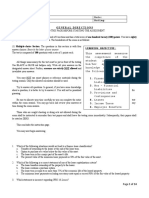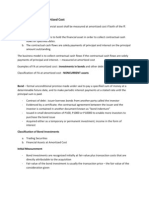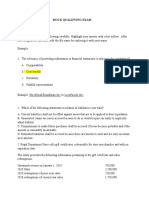FAR 4307 Investment in Equity Securities
FAR 4307 Investment in Equity Securities
Uploaded by
ATHALIAH LUNA MERCADEJASCopyright:
Available Formats
FAR 4307 Investment in Equity Securities
FAR 4307 Investment in Equity Securities
Uploaded by
ATHALIAH LUNA MERCADEJASOriginal Description:
Original Title
Copyright
Available Formats
Share this document
Did you find this document useful?
Is this content inappropriate?
Copyright:
Available Formats
FAR 4307 Investment in Equity Securities
FAR 4307 Investment in Equity Securities
Uploaded by
ATHALIAH LUNA MERCADEJASCopyright:
Available Formats
ReSA - THE REVIEW SCHOOL OF ACCOUNTANCY
CPA Review Batch 43 May 2022 CPA Licensure Examination Week No. 5
FINANCIAL ACCOUNTING & REPORTING C. UBERITA J. BINALUYO G. MACARIOLA
FAR-4307: INVESTMENT IN EQUITY SECURITIES
Classification of Investments
Investment in equity securities – representing ownership interest in an equity (e.g. ordinary share or
preference share) or the right to acquire ownership interest (e.g. share options, share warrants and etc.). This
term however does not encompass callable or redeemable preference share, treasury share and convertible
bonds.
Classification of Equity Securities
Investment in subsidiary – when the ownership interest is more than 50%.
Investment in associate – when the investor has a significant influence over the investee. In the absence of
evidence to the contrary, significant influence should be presumed when the investor holds 20% or more of the
investee’s voting stock.
Other equity securities (Financial Instruments) – are investments in the investee’s equity without controlling
interest or significant influence. They are normally classified as:
Marketable – equity securities with readily determinable market value.
Non-marketable – equity securities without readily determinable market value.
Designation of Investment in Equity Securities (Financial Instruments)
Investment security to profit or loss – these are equity securities that are acquired principally for the
purpose of generating a profit from short-term fluctuations in price or dealer’s margin.
Investment in equity through other comprehensive income – are those financial assets that are not (a)
loans and receivables originated by the enterprise (b) financial assets for trading.
Equity investments where an investor has no significant influence over the operation of an investee should
be designated as investment in equity measured at fair value through profit or loss. However, some equity
instruments are purchased for strategic purposes and are not held with the primary objective of realizing a
profit from increases in the value of the instruments. An equity investment in an investee company that is
made for the purpose of cementing or establishing a long-term trading relationship. IFRS 9 permits an entity,
on initial recognition of equity investments that are not held for trading, to make an irrevocable election to
present changes in the fair value of those instruments in other comprehensive income. However, dividends
on such investments would be presented in profit or loss to the extent that they are a return on, rather than
a return of, the investments. With these changes, there would be no transfers from other comprehensive
income to profit or loss (no recycling or reclassification adjustments, and hence no impairment requirements.
In other words, all fair value changes, including impairment losses, would be dealt with in other
comprehensive income and remain as component of equity.
A financial asset classified as investment to profit or loss:
* acquired or incurred principally for the purpose of selling or repurchasing it in the near term,
* part of the portfolio of identified financial instruments that are managed together and for which there is
evidence of a recent actual pattern and for which there is evidence of a recent actual pattern of short-term
profit taking, or
* a derivative (except for derivative that is a financial guarantee contract or designated and effective hedging
instrument).
Financial asset held for trading (investment to profit or loss) include:
1. debt and equity securities that are actively traded by the entity
2. loans and receivables acquired by the entity with the intention of making a short-term profit from price or
dealer’s margin.
3. securities held under repurchase agreement.
Classification of investments depends on the percentage of the investee voting shares that
is held by the investor
Holdings of <20% Holdings between 20 to 50% Holdings of >50%
Level of influence Little or none Significant Control
Valuation method Fair value method Equity method Consolidation
The accounting and reporting for equity investments depend on the level of influence and
type of security involved:
Unrealized
Category Valuation Other Income Effects
Gain or Loss
Holding less than 20%:
(1) Trading Fair Value To profit or loss Dividends declared, gain/loss on sale
(2) Non-trading Fair value To OCI Dividends declared
Holdings between 20% Equity Not recognized Proportionate share of net income and
and 50% gain or loss from sale
Holdings of more than Consolidation Not recognized Not applicable
50%
Page 1 of 3 0915-2303213/0908-6567516 www.resacpareview.com
ReSA – THE REVIEW SCHOOL OF ACCOUNTANCY FAR-4307
Week 5: INVESTMENT in EQUITY SECURITIES
Initial Measurement of Equity Investment:
Financial instruments classified as investment assets under the category “Investment to Profit or Loss” are
initially recorded at their acquisition cost. The acquisition cost is the fair value of the securities acquired which
is equal to the fair value of the consideration given up to acquire the instruments. Any transaction costs incurred
related to the acquisition of the instrument is recognized outright as an expense.
Financial instruments classified as investment assets under the category "Investment to other comprehensive
income" measured initially at historical cost which is equal to the fair market value of the acquired security plus
any transaction costs that are directly attributable to the acquisition such as the following: broker’s fee,
commissions, levies by regulatory agencies and securities exchanges and transfer taxes and duties.
Reclassification of investment between fair value to profit or loss and fair value to other
comprehensive income: (PFRS 9)
Classification is done at the irrevocable designation of the entity at initial recognition.
Measurement Subsequent to Initial Recognition:
Financial instruments classified as equity investment under the category Investment to profit or loss (held for
trading) are re-measured at fair market value. Changes in the fair market value subsequent to acquisition are
reported in the profit or loss of the period.
After initial recognition, investments in equity instruments that are designated as Investment to Other
Comprehensive Income should be measured at fair value, with no deduction for sale or disposal costs. With
the exception of dividends received, the associated gains and losses (including any related foreign exchange
component) should be recognized in other comprehensive income. Amounts presented in other comprehensive
income should not be subsequently transferred to profit or loss, although the cumulative gain or loss may be
transferred within equity.
Accounting For Dividends on Equity (Ordinary Share) Instruments:
(a) Cash dividend – is recognized as income on the date of declaration and measured at the face amount of
dividend.
(b) Property dividend – is recognized as a dividend income on the date of declaration but it is being
measured at the fair market value of the property.
(c) Share dividends – no amount of income is recognized. Only a memorandum entry is required to
acknowledge the receipt of new shares.
(d) Shares in lieu of cash dividends – are recognized as income and measured at the fair market value of
the shares.
(e) Cash in lieu of shares – not a dividend income, the cash received is the proceeds on the “as if” sale of
shares.
(f) Preference share (new financial debt or equity instrument) dividend – treated as dividend income
Shares received in exchange for old shares or share splits (split-up or reverse split) – only a
memorandum entry is required to acknowledge the receipt of new shares in exchange for shares originally held.
******************************************************************************************************
1. On January 1, 2019, Backstreet Co. purchased 15,000 shares of Nsync Inc. for P600,000. Commission paid
to the broker is 5% of the total purchase price. On December 31, 2019 and December 31, 2020, the shares
were quoted at P50 and P52 per share, respectively. On January 3, 2021, all of the 15,000 shares were sold
at P62 per share. Commission paid for the sale amounted to P50,000.
APPLICABLE STANDARD PFRS 9 PFRS 9
CLASSIFICATION FVTPL FVTOCI
1. At what amount should the equity investment be initially
recorded at?
2. How much is the unrealized gain (loss) recognized in its
December 31, 2019 profit or loss?
3. How much is the unrealized gain (loss) recognized in its
other comprehensive income in 2019?
4. How much is the cumulative unrealized gain (loss) in other
comprehensive income as of December 31, 2019?
5. How much is the cumulative unrealized gain (loss) in other
comprehensive income as of December 31, 2020?
6. How much is the realized gain (loss) recognized it profit or
loss as a result of sale of investments on January 3, 2021?
7. How much is the cumulative unrealized gain (loss) in other
comprehensive income as of December 31, 2021?
*Assume that Backstreet Co. elect to transfer any cumulative balance on OCI when the investment is
disposed.
Page 2 of 3 0915-2303213/0908-6567516 www.resacpareview.com
ReSA – THE REVIEW SCHOOL OF ACCOUNTANCY FAR-4307
Week 5: INVESTMENT in EQUITY SECURITIES
2. Calling Company began business in January of 2021. During the year, Calling purchased a portfolio of
securities listed below. In its December 31, 2021 balance sheet, Calling appropriately reported a
P300,000 debit balance in its “Unrealized gain/loss” account. The composition of the securities did
not change during the year 2022. Pertinent data are as follows:
Security Cost Market Value, December 31, 2022
BE (FVPL) P2,000,000 P2,750,000
BI (FVOCI) 3,600,000 3,250,000
KO (FVOCI) 3,900,000 4,000,000
P9,500,000 P10,000,000
Q1: How much is the carrying value of Investment at FVOCI on December 31, 2021?
a. 9,800,000 c. 9,500,000
b. 9,200,000 d. 10,000,000
Q2: How much is the unrealized gain or loss that should presented in the Equity section of the
Balance Sheet on December 31, 2022?
a. 500,000 UG c. 800,000 UG
b. 500,000 UL d. 800,000 UL
3. Swans Corporation acquired 10,000 Maids Company shares on February 5, 2021 at P50 which include P10 per
share broker’s fees and commissions. A P50,000 cash dividends were received from Maids Company on March
20, 2021. These dividends were declared on January 5 payable to shareholders as of February 10. Maids shares
were split 2 for 1 on November 1. The shares were selling at P32 per share on December 31, 2021. The
investments were designated as FVPL.
Q1: How much is initial carrying value of investment on the date of acquisition?
a. 500,000 c. 450,000
b. 400,000 d. 350,000
Q2: How much should be recognized as dividend income?
a. 50,000 c. 290,000
b.100,000 d. 0
4. Geese Corp. received dividends from ordinary share (15%) and preference share (25%) investments during
the current year:
• A cash dividend of P 100,000 from ordinary share investment
• A cash dividend of P 50,000 from preference share investment
• A property dividend costing P 500,000 which had a market value of P600,000
How much is the total dividend income that should reported for the current year?
a. 750,000 c. 150,000
b. 700,000 d. 650,000
5. Comfort Company purchased 10,000 shares of Velvet ordinary shares at P90 share on January 3, 2019. On
December 31, 2019 Comfort received 2,000 shares of Velvet ordinary shares in lieu of cash dividend of P10
per share. On this date, the Velvet ordinary share has a quoted market price of P60 per share. In its 2019
statement of comprehensive income, Comfort should report dividend income at
a. P120,000 c. P10,000
b. P100,000 d. none
6. On January 2020, Golden Company invested in P900,000 in equity securities representing 15% interest in
Rings Company. Golden Company incurred transaction cost of P100,000 related to the acquisition of
the security. On December 31, 2020, this investment has a market value of P950,000. On July 1, 2021,
Golden Company sold all the investments for P1,200,000.
Q1: What amount of gain on sale should Golden Company recognized in profit or loss
assuming the security was classified as Investment at FVPL?
a. 250,000 c. 200,000
b. 300,000 d. 0
Q2: How much is the amount transferred to Retained earnings upon sale assuming the
security was classified as Investment at FVOCI?
a. 50,000 c. 200,000
b. 300,000 d. 250,000
Page 3 of 3 0915-2303213/0908-6567516 www.resacpareview.com
You might also like
- Time Value of Money (TVOM) : Principles of Engineering Economic Analysis, 5th Edition100% (1)Time Value of Money (TVOM) : Principles of Engineering Economic Analysis, 5th Edition154 pages
- FARAP 4406A Investment in Equity SecuritiesNo ratings yetFARAP 4406A Investment in Equity Securities8 pages
- Accounting For Investments in Debt InstrumentsNo ratings yetAccounting For Investments in Debt Instruments4 pages
- V16 and V17 TAX-2001 (Preferential Taxation 1)No ratings yetV16 and V17 TAX-2001 (Preferential Taxation 1)5 pages
- 7.30.22 Am Investments-In-Equity-InstrumentsNo ratings yet7.30.22 Am Investments-In-Equity-Instruments4 pages
- Cost Not Qualifying For Recognition (Expensed Immediately) : Order of Priority: 1) Fair Value of Property ReceivedNo ratings yetCost Not Qualifying For Recognition (Expensed Immediately) : Order of Priority: 1) Fair Value of Property Received1 page
- Depreciated Separately.: Property, Plant and EquipmentNo ratings yetDepreciated Separately.: Property, Plant and Equipment5 pages
- ReSA B42 FAR First PB Exam Questions Answers Solutions-1No ratings yetReSA B42 FAR First PB Exam Questions Answers Solutions-125 pages
- Lecture Notes On Trade and Other ReceivablesNo ratings yetLecture Notes On Trade and Other Receivables5 pages
- Pcoa 008 - Intermediate Accounting Ii Learning OutcomesNo ratings yetPcoa 008 - Intermediate Accounting Ii Learning Outcomes19 pages
- FAR 4310 Investment Property Other Fund InvestmentsNo ratings yetFAR 4310 Investment Property Other Fund Investments5 pages
- Far Week 6 Investment Properties RevieweesNo ratings yetFar Week 6 Investment Properties Reviewees4 pages
- Answer The Following With Speed and Accuracy. Solutions Must Be DisclosedNo ratings yetAnswer The Following With Speed and Accuracy. Solutions Must Be Disclosed4 pages
- 1 ULO 1 To 3 Week 1 To 3 SHE Activities (AK)No ratings yet1 ULO 1 To 3 Week 1 To 3 SHE Activities (AK)10 pages
- Accounts Receivable and Estimating Doubtful AccountsNo ratings yetAccounts Receivable and Estimating Doubtful Accounts7 pages
- 7084 Multiple Choice Small Entities Lecture Notes and SolutionNo ratings yet7084 Multiple Choice Small Entities Lecture Notes and Solution4 pages
- FAR - Biological Assets and Agricultural Produce67% (3)FAR - Biological Assets and Agricultural Produce2 pages
- Intthry at Long Quiz 1 Answer Key 012718No ratings yetIntthry at Long Quiz 1 Answer Key 01271812 pages
- CPA Review School of The Philippines ManilaNo ratings yetCPA Review School of The Philippines Manila4 pages
- FAR-4206 (Government Grant & Agriculture)No ratings yetFAR-4206 (Government Grant & Agriculture)6 pages
- Mock Phinma Exam: Intermediate Accounting 3 Name: Date: Section: RatingNo ratings yetMock Phinma Exam: Intermediate Accounting 3 Name: Date: Section: Rating14 pages
- Property, Plant and Equipment Property, Plant and EquipmentNo ratings yetProperty, Plant and Equipment Property, Plant and Equipment5 pages
- Acctg 4 Quiz 3 Debt Restructuring Payables 1No ratings yetAcctg 4 Quiz 3 Debt Restructuring Payables 111 pages
- Insurance Contracts and Service ConcessionNo ratings yetInsurance Contracts and Service Concession2 pages
- 6806 Operating Segment and Interim ReportingNo ratings yet6806 Operating Segment and Interim Reporting2 pages
- Accounting For Shareholders Equity KINGNo ratings yetAccounting For Shareholders Equity KING11 pages
- Instructions: Answer The Following Carefully. Highlight Your Answer With Color Yellow. AfterNo ratings yetInstructions: Answer The Following Carefully. Highlight Your Answer With Color Yellow. After8 pages
- FAR-4207 (Investment in Equity Securities)No ratings yetFAR-4207 (Investment in Equity Securities)3 pages
- 06A Investment in Equity Securities (Financial Assets at FMV, Investment in Associates)100% (1)06A Investment in Equity Securities (Financial Assets at FMV, Investment in Associates)6 pages
- FAR 4309 Investment in Debt Securities 2No ratings yetFAR 4309 Investment in Debt Securities 26 pages
- Acc 106 - P1 Examination, Pa 1: Your Email Will Be Recorded When You Submit This FormNo ratings yetAcc 106 - P1 Examination, Pa 1: Your Email Will Be Recorded When You Submit This Form18 pages
- Acc 106 - P1 Examination, Pa 2: Your Email Will Be Recorded When You Submit This FormNo ratings yetAcc 106 - P1 Examination, Pa 2: Your Email Will Be Recorded When You Submit This Form17 pages
- Details of Unclaimed and Unpaid Dividend As On 29092018No ratings yetDetails of Unclaimed and Unpaid Dividend As On 29092018155 pages
- Fi Account Statement 01 Apr 2022 - 23 Apr 2022No ratings yetFi Account Statement 01 Apr 2022 - 23 Apr 202216 pages
- CanaraHSBCOBC Sampoorn Kavach Plan Web BrochureNo ratings yetCanaraHSBCOBC Sampoorn Kavach Plan Web Brochure3 pages
- The Benefits of Business Accounting Software: Xero Intuit Quickbooks MyobNo ratings yetThe Benefits of Business Accounting Software: Xero Intuit Quickbooks Myob3 pages
- Discount Rate (R) Periods: Present Value TableNo ratings yetDiscount Rate (R) Periods: Present Value Table2 pages
- SEBI Financial Inclusion, Alternate Source of Finance, Private andNo ratings yetSEBI Financial Inclusion, Alternate Source of Finance, Private and34 pages
- Peran Bank Sentral Dalam Stabilitas Sistem Keuangan (SSK) Dan Implementasi Jaring Pengaman Sektor Keuangan (JPSK)No ratings yetPeran Bank Sentral Dalam Stabilitas Sistem Keuangan (SSK) Dan Implementasi Jaring Pengaman Sektor Keuangan (JPSK)16 pages
- Vijay Corporate Solutions Opc Private LimitedNo ratings yetVijay Corporate Solutions Opc Private Limited6 pages
- Mutual Funds or ULIPS? - A Cost and Return Basis Analysis: Assistant Professor (SG), Saveetha Engineering CollegeNo ratings yetMutual Funds or ULIPS? - A Cost and Return Basis Analysis: Assistant Professor (SG), Saveetha Engineering College22 pages
- Consolidated Balance Sheet of Scheduled Commercial Banks (Excluding Regional Rural Banks)No ratings yetConsolidated Balance Sheet of Scheduled Commercial Banks (Excluding Regional Rural Banks)1 page
- Hsu - Sara - Li - Jianjun China - S Fintech Explosion - Disruption - Innovation - and Survival Columbia Univ100% (1)Hsu - Sara - Li - Jianjun China - S Fintech Explosion - Disruption - Innovation - and Survival Columbia Univ361 pages































































































